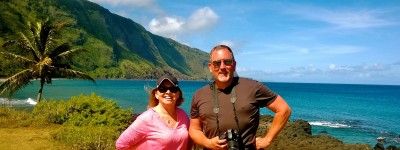 Kalaupapa National Historical Park is bittersweet, not the kind of place you travel to buy souvenirs. It is the kind of place from which you bring back lasting memories. Novelist, poet, essayist, and travel writer, Robert Louis Stevenson described it as a prison fortified by nature. It is not easy to get to but so worth the effort. On the Hawaiian island of Molokai, it is surrounded by the crashing waves of the pacific ocean on three sides and 1,700 ft high sea cliffs on the other. There is to say the least, limited access to the peninsula. You can fly in by small plane, hike or ride on mule back down the 2.9 mile steep trail with 26 switchbacks and the most breathtaking views of the Pacific Ocean. Unless you are a guest of one of the few residents, the only way to visit is with Damien Tours. Very exclusive, only 100 people are permitted to enter daily, and that includes resident’s guests.
Kalaupapa National Historical Park is bittersweet, not the kind of place you travel to buy souvenirs. It is the kind of place from which you bring back lasting memories. Novelist, poet, essayist, and travel writer, Robert Louis Stevenson described it as a prison fortified by nature. It is not easy to get to but so worth the effort. On the Hawaiian island of Molokai, it is surrounded by the crashing waves of the pacific ocean on three sides and 1,700 ft high sea cliffs on the other. There is to say the least, limited access to the peninsula. You can fly in by small plane, hike or ride on mule back down the 2.9 mile steep trail with 26 switchbacks and the most breathtaking views of the Pacific Ocean. Unless you are a guest of one of the few residents, the only way to visit is with Damien Tours. Very exclusive, only 100 people are permitted to enter daily, and that includes resident’s guests.
The back story ….
The first case of leprosy in Hawaii was documented back in 1835. In January of 1865, an act to prevent the spread of Leprosy was signed into law by King Kamehameha V setting aside land for the isolation of people with leprosy. On January 6, 1866, the first group of leprosy patients, 9 men and 3 women were remanded to Kalawao, Molokai.
Over the years, thousands of people who had contracted leprosy (aka Hanson’s Disease) were brought to the peninsula by boat, tossed overboard and forced to swim to the shore in the violent surf. Many never made it. For those that did, It was a cruel and terrifying fate, imprisonment by government and a body ravaged by disease.
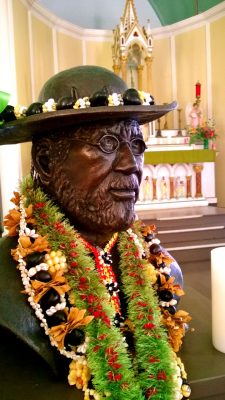 Father Damien, a Belgian priest arrived to the settlement in 1873 at the age of 33. The young priest tended to the physical, spiritual and emotional needs of the patients, building hospitals, orphanages, churches, coffins, digging waterlines and graves. After 12 indomitable years, Father Damien was diagnosed with leprosy. Unstoppable he continued his work until his death in 1889. He was 49 years old.
Father Damien, a Belgian priest arrived to the settlement in 1873 at the age of 33. The young priest tended to the physical, spiritual and emotional needs of the patients, building hospitals, orphanages, churches, coffins, digging waterlines and graves. After 12 indomitable years, Father Damien was diagnosed with leprosy. Unstoppable he continued his work until his death in 1889. He was 49 years old.
It wasn’t until 1946 that they began the use of the sulfone antibiotics at Kalaupapa, and the therapy was tested on six patients and it seemed to produce changes overnight. It took until 1969 to abolish the isolation laws. All new patients would be treated as outpatients. In 1980 Public Law 96-565 is signed by President Carter, establishing Kalaupapa National Historical Park. In addition, the
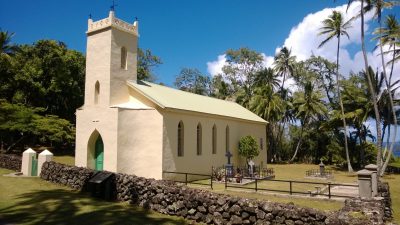 State Legislature once again decrees the term “Hansen’s Disease” rather than “leprosy” to be the official terminology in Hawaii in an effort to thwart the stigma that was associated with the disease.
State Legislature once again decrees the term “Hansen’s Disease” rather than “leprosy” to be the official terminology in Hawaii in an effort to thwart the stigma that was associated with the disease.
The tour ….
After a 90 minute mule ride down the steep cliffs, we arrived on the beach that could have easily been a movie location. We parted company with our mules, leaving them in a shaded corral with our mule skinners (guides) and boarded a yellow school bus. The bus traveled on the single lane road on the leeward side of settlement and as we rolled along we saw no other vehicles. We made stops at the bookstore, a place to get a cold drink and Mother Marianne Cope’s burial site. After Father Damien was diagnosed with leprosy, it was Mother Marianne who ran the Bishop Home which housed 103 girls. She remained on the island until 1918 when she died at the age of 80.
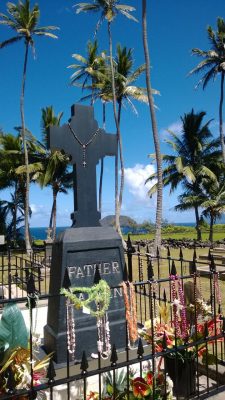 We drove past meticulously tended resident homes, a grocery store and the peninsula’s one and only gas station. It was eerily peaceful. We stopped at St. Francis Catholic Church where we were introduced to Father Patrick Killilea, a native of Ireland, who told us he felt he was destined to serve as pastor of St. Francis after a brief visit in 2004. His destiny was fulfilled in 2012. He holds service every Sunday, for 20+ parishioners of which about a half of a dozen are patient residents. Their presence is evident by the hand written notes they leave in pews for visitors requesting they not touch or use their bibles and hymnals.
We drove past meticulously tended resident homes, a grocery store and the peninsula’s one and only gas station. It was eerily peaceful. We stopped at St. Francis Catholic Church where we were introduced to Father Patrick Killilea, a native of Ireland, who told us he felt he was destined to serve as pastor of St. Francis after a brief visit in 2004. His destiny was fulfilled in 2012. He holds service every Sunday, for 20+ parishioners of which about a half of a dozen are patient residents. Their presence is evident by the hand written notes they leave in pews for visitors requesting they not touch or use their bibles and hymnals.
We boarded the bus again heading to Kalawao on the windward side of the island. The ride is bumpy and dusty. We 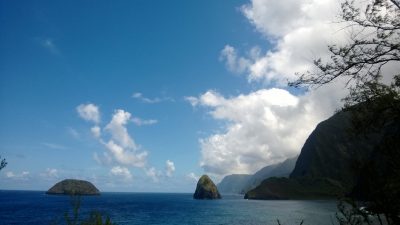 stopped in front of St. Philomena’s church which Father Damien built, and to which his gravesite is adjacent. It is the only remaining building from the early settlement of Kalawao.
stopped in front of St. Philomena’s church which Father Damien built, and to which his gravesite is adjacent. It is the only remaining building from the early settlement of Kalawao.
We ate our brown bag lunch consisting of a simple meat and cheese sandwich on white bread, a bag of chips and bottle of water overlooking the thrashing waves way down below, the very place where patients were dropped off.
No one was talking. It was a time of quiet reflection of beauty and tragedy, despair and hope, fear and charity.
There are fourteen cemeteries located on Kalaupapa and over 7,000 people have been buried on the peninsula since 1866. Sacred ground indeed.
We mounted our mules for the one hour and fifteen minute assent. It was an easier trip on the way up. The mules were looking forward to their dinner upon arrival at the top and we a cold beverage back at the Hotel Molokai.
What’s your favorite adventure in Hawaii?
Here are some of our other Molokai adventures:
Molokai: An Island Paradise
Kalaupapa National Historic Park: Bittersweet Beauty
Has the weather got you down? We have the Rx with our warm weather favorites!
The Most Incredible Travel Year Ever
There’s Nothing Touristy about Molokai
From Sea Cliffs to Ski Trips, Anatomie has got you covered
Molokai Mule Ride (video)

Trackbacks/Pingbacks